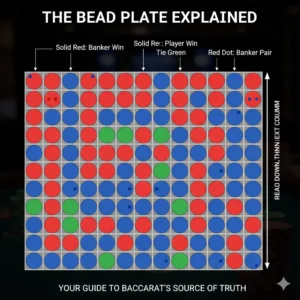An Analyst’s Introduction: The Scoreboard’s Source of Truth
Welcome to the analyst’s desk. In the complex world of baccarat strategy, there is no tool more fundamental, yet often misunderstood, than the scoreboard. And at the heart of all scoreboard analysis lies one simple, powerful grid: The Bead Plate.
Many guides will list the five baccarat roads as a collection of equals. This is a mistake. To truly master the flow and patterns of baccarat, you must understand that the Bead Plate is the foundation—the source of truth from which all other analysis is born.
That is the purpose of this guide. We will begin with a masterclass on the Bead Plate, deconstructing it step-by-step. From there, we will show you how this foundational knowledge allows you to effortlessly understand the Big Road and, subsequently, the complex derived roads. But first, a critical principle must be established.
A Crucial Disclaimer: History vs. Prediction (The Gambler’s Fallacy)
Let’s be unequivocally clear: baccarat scoreboards are historical documents, not crystal balls. The Bead Plate perfectly records what has already happened, but it cannot predict what will happen next. Each hand in baccarat is an independent event with fixed mathematical odds. The common belief that a series of past results influences a future outcome is a cognitive bias known as the Gambler’s Fallacy. An analyst’s first duty is to respect the math. This guide will teach you to be an expert historian of the shoe, not a fortune-teller.
The Purpose of This Guide
Our mission is to provide you with a methodical, step-by-step masterclass that transforms those cryptic grids into a clear language. You will learn to read the Bead Plate with precision, understand how it gives birth to the other roads, and use this knowledge to become a more informed and confident player.
Deconstructing The Bead Plate: A Step-by-Step Analysis
Let’s begin with the foundation. The Bead Plate, also known as the Bead Road or Cube Road, is the most literal of all the baccarat scoreboards.
What is the Bead Plate? A Literal Diary of the Shoe
Think of the Bead Plate as the official court record of the shoe. Its sole purpose is to provide a raw, chronological log of every single hand’s outcome, in the exact order it occurred. It does not group streaks or look for patterns; it simply records. This unfiltered view is what makes it the “source of truth” for all other scoreboards.
How to Read the Grid: Symbols and Colors
The Bead Plate is a grid, typically six rows deep and several columns wide. The marking process starts at the top-left cell and moves down to the bottom of the column. Once a column is full, you move to the adjacent column to the right and start again from the top.
The symbols are simple and color-coded for instant recognition:
Solid Red Circle: Banker was the winning hand.
Solid Blue Circle: Player was the winning hand.
Solid Green Circle: The result was a Tie.
A Red Dot in the top-left corner of a circle indicates a Banker Pair was dealt.
A Blue Dot in the bottom-right corner of a circle indicates a Player Pair was dealt.
A single circle can have both dots if both a Banker Pair and a Player Pair were dealt on the same hand.
Marking the Bead Plate: A Practical Example
Let’s walk through the first ten hands of a hypothetical shoe to see this in action.
Hand 1: Banker wins. (A Red circle is placed in the first cell).
Hand 2: Player wins, with a Player Pair. (A Blue circle with a blue dot is placed below the first).
Hand 3: Banker wins. (A Red circle is placed below the second).
Hand 4: Banker wins, with a Banker Pair. (A Red circle with a red dot is placed below the third).
Hand 5: Tie wins. (A Green circle is placed below the fourth).
Hand 6: Player wins. (A Blue circle is placed at the bottom of the first column).
Hand 7: Banker wins. (The first column is full, so we move to the top of the second column and place a Red circle).
Hand 8: Player wins.
Hand 9: Player wins.
Hand 10: Banker wins.
After ten hands, you have a clear, sequential history of the shoe. An analyst can glance at the Bead Plate and immediately see the ratio of Banker to Player wins and the frequency of Ties and Pairs.
From Raw Data to Patterns: Understanding The Big Road
If the Bead Plate is the raw diary, the Big Road is the first chapter of the story. It takes the same data from the Bead Plate but organizes it to make streaks and patterns instantly visible.
Constructing the Big Road
The Big Road is where pattern visualization begins. Instead of a new cell for every hand, a new column is started only when the winning hand switches between Banker and Player.
Wins are marked with hollow circles (Red for Banker, Blue for Player).
If Banker wins three times in a row, you place three Red circles vertically down the first column.
If the fourth hand is a Player win, you start a new column to the right with a single Blue circle.
This method visually separates streaks, making “dragons” (long, unbroken streaks) immediately apparent.
Marking Ties and Pairs on the Big Road
Ties: A Tie doesn’t start a new column. It’s marked with a green slash across the most recently drawn circle. If two ties happen in a row, a number “2” is placed next to the slash.
Pairs: Banker and Player Pairs are marked with the same red and blue dots used on the Bead Plate.
By translating the Bead Plate’s raw data to the Big Road, you’ve taken the first step in baccarat analysis.
The Derived Roads: Advanced Pattern Analysis
Now we move into advanced territory. The three “derived roads” are abstract and can be confusing, but their purpose is simple. They analyze the data in the Big Road to tell you if the shoe is behaving in a patterned, predictable way or a chaotic, choppy way.
The Golden Rule: For derived roads, Red = Patterned, Blue = Chaotic.
The Big Eye Boy
This road answers the question: “Is there a pattern compared to one column ago?” It checks for repetition in the Big Road’s behavior, starting after the first hand of the second column.
The Small Road
This road asks: “Is there a pattern compared to two columns ago?” It looks for more established patterns, starting after the first hand of the third column on the Big Road.
The Cockroach Pig
The most abstract road asks: “Is there a pattern compared to three columns ago?” It looks for long-term patterns in the shoe, starting after the first hand of the fourth column on the Big Road.
For each of these roads, the rules for marking Red (patterned) or Blue (chaotic) are based on a methodical comparison of column depths on the Big Road. Mastering their specific rules is the mark of an advanced player.
The Analyst’s View: Synthesizing the Information
An expert player doesn’t look at just one road; they synthesize the information from all of them. They use the Bead Plate for a quick, unfiltered count of outcomes. They use the Big Road to spot dominant streaks. They use the derived roads to get a feel for the shoe’s “texture”—is it orderly or messy?
This synthesis allows for more informed decisions, such as deciding when to press a bet during a consistent trend or when to sit out a hand during a chaotic, unpredictable shoe. The most common mistake is to forget that this is all historical analysis. The most skilled players use this information as a guide for their strategy, not as a guarantee of success.
Conclusion: Mastering Baccarat’s Language
You now understand the central role of the Bead Plate. It is not just another scoreboard; it is the genesis of all baccarat analysis. It is the raw data, the diary, the source of truth. Every circle and slash on the more complex roads owes its existence to the simple, chronological record kept by the Bead Plate.
By mastering this foundational tool, you have built the base upon which all advanced baccarat knowledge stands. You can now confidently approach any baccarat table, understand the language of the roads, and make more informed decisions. Use this knowledge to deepen your appreciation for the game’s elegant patterns, while always playing responsibly.

